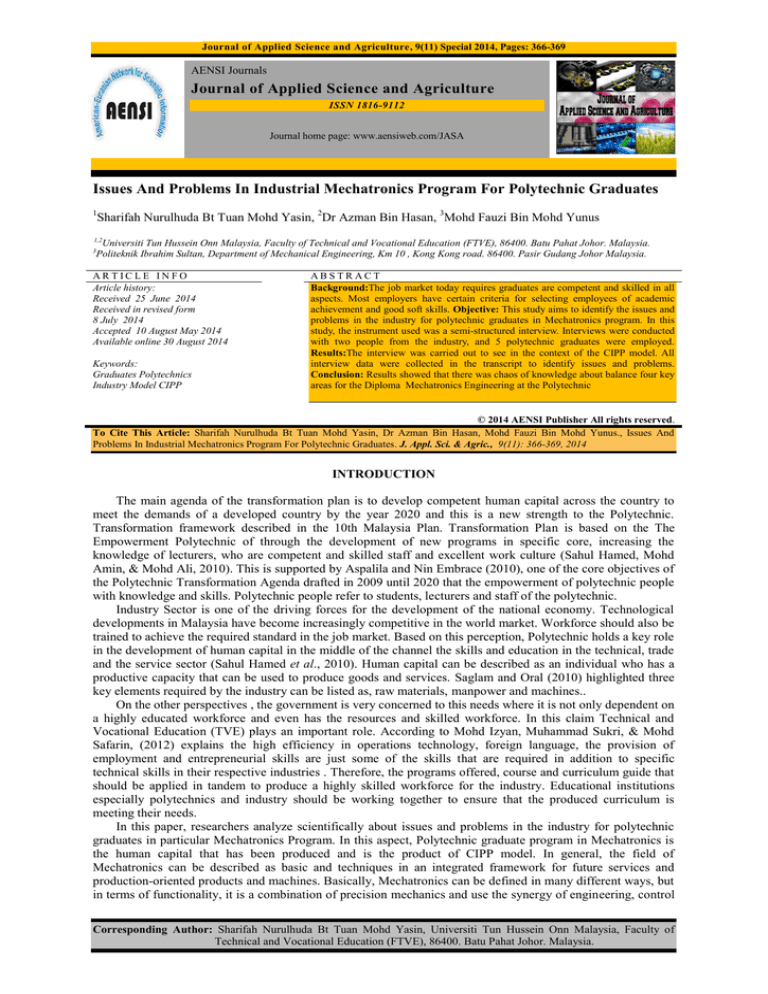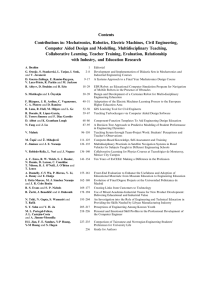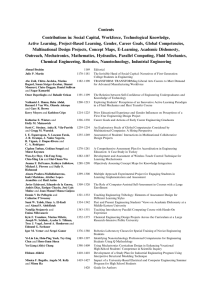
Journal of Applied Science and Agriculture, 9(11) Special 2014, Pages: 366-369
AENSI Journals
Journal of Applied Science and Agriculture
ISSN 1816-9112
Journal home page: www.aensiweb.com/JASA
Issues And Problems In Industrial Mechatronics Program For Polytechnic Graduates
1
Sharifah Nurulhuda Bt Tuan Mohd Yasin, 2Dr Azman Bin Hasan, 3Mohd Fauzi Bin Mohd Yunus
1,2
3
Universiti Tun Hussein Onn Malaysia, Faculty of Technical and Vocational Education (FTVE), 86400. Batu Pahat Johor. Malaysia.
Politeknik Ibrahim Sultan, Department of Mechanical Engineering, Km 10 , Kong Kong road. 86400. Pasir Gudang Johor Malaysia.
ARTICLE INFO
Article history:
Received 25 June 2014
Received in revised form
8 July 2014
Accepted 10 August May 2014
Available online 30 August 2014
Keywords:
Graduates Polytechnics
Industry Model CIPP
ABSTRACT
Background:The job market today requires graduates are competent and skilled in all
aspects. Most employers have certain criteria for selecting employees of academic
achievement and good soft skills. Objective: This study aims to identify the issues and
problems in the industry for polytechnic graduates in Mechatronics program. In this
study, the instrument used was a semi-structured interview. Interviews were conducted
with two people from the industry, and 5 polytechnic graduates were employed.
Results:The interview was carried out to see in the context of the CIPP model. All
interview data were collected in the transcript to identify issues and problems.
Conclusion: Results showed that there was chaos of knowledge about balance four key
areas for the Diploma Mechatronics Engineering at the Polytechnic
© 2014 AENSI Publisher All rights reserved.
To Cite This Article: Sharifah Nurulhuda Bt Tuan Mohd Yasin, Dr Azman Bin Hasan, Mohd Fauzi Bin Mohd Yunus., Issues And
Problems In Industrial Mechatronics Program For Polytechnic Graduates. J. Appl. Sci. & Agric., 9(11): 366-369, 2014
INTRODUCTION
The main agenda of the transformation plan is to develop competent human capital across the country to
meet the demands of a developed country by the year 2020 and this is a new strength to the Polytechnic.
Transformation framework described in the 10th Malaysia Plan. Transformation Plan is based on the The
Empowerment Polytechnic of through the development of new programs in specific core, increasing the
knowledge of lecturers, who are competent and skilled staff and excellent work culture (Sahul Hamed, Mohd
Amin, & Mohd Ali, 2010). This is supported by Aspalila and Nin Embrace (2010), one of the core objectives of
the Polytechnic Transformation Agenda drafted in 2009 until 2020 that the empowerment of polytechnic people
with knowledge and skills. Polytechnic people refer to students, lecturers and staff of the polytechnic.
Industry Sector is one of the driving forces for the development of the national economy. Technological
developments in Malaysia have become increasingly competitive in the world market. Workforce should also be
trained to achieve the required standard in the job market. Based on this perception, Polytechnic holds a key role
in the development of human capital in the middle of the channel the skills and education in the technical, trade
and the service sector (Sahul Hamed et al., 2010). Human capital can be described as an individual who has a
productive capacity that can be used to produce goods and services. Saglam and Oral (2010) highlighted three
key elements required by the industry can be listed as, raw materials, manpower and machines..
On the other perspectives , the government is very concerned to this needs where it is not only dependent on
a highly educated workforce and even has the resources and skilled workforce. In this claim Technical and
Vocational Education (TVE) plays an important role. According to Mohd Izyan, Muhammad Sukri, & Mohd
Safarin, (2012) explains the high efficiency in operations technology, foreign language, the provision of
employment and entrepreneurial skills are just some of the skills that are required in addition to specific
technical skills in their respective industries . Therefore, the programs offered, course and curriculum guide that
should be applied in tandem to produce a highly skilled workforce for the industry. Educational institutions
especially polytechnics and industry should be working together to ensure that the produced curriculum is
meeting their needs.
In this paper, researchers analyze scientifically about issues and problems in the industry for polytechnic
graduates in particular Mechatronics Program. In this aspect, Polytechnic graduate program in Mechatronics is
the human capital that has been produced and is the product of CIPP model. In general, the field of
Mechatronics can be described as basic and techniques in an integrated framework for future services and
production-oriented products and machines. Basically, Mechatronics can be defined in many different ways, but
in terms of functionality, it is a combination of precision mechanics and use the synergy of engineering, control
Corresponding Author: Sharifah Nurulhuda Bt Tuan Mohd Yasin, Universiti Tun Hussein Onn Malaysia, Faculty of
Technical and Vocational Education (FTVE), 86400. Batu Pahat Johor. Malaysia.
367
Sharifah Nurulhuda Bt Tuan Mohd Yasin et al, 2014
Journal of Applied Science and Agriculture, 9(11) Special 2014, Pages: 366-369
theory, computer science, technology, sensors and actuators. All are designed to improve products and processes
to focus on mechanics, electronics, control and computing technologies and molecular engineering. Combined
fit to produce a simpler system, ergonomic, reliable and versatile. (Ministry Of Human Resource, 2008). Fields
Mechatronics provide extensive employment opportunities even in small companies also require auditors
general to perform the functions of mechanical and electrical engineering. (Allen, 2006).
Methodology:
There were approach used in this study: semi-structured interview .The purpose of this interview is to
gather information about issue and the problem of employment among polytechnic graduates in the fields of
task allocation in Mechatronics industry. A few sessions interviews were carried out with engineers and
technicians in the factory .In addition, the researchers also have selected five graduates in Mechatronics to be
interviewed.
Results:
Preliminary analysis conducted on graduates who have worked in the industry Mechatronics, a slight
confusion of reference in the industry. Graduates who have Mechatronics background should be competent
working in the Mechanical, Electronic, System, Electromechanically, Oil & Gas, Manufacturing, and
Automotive.
Interviews were carried out with the assistant engineer to examine the need for knowledge and expertise in
the field of industrial tasks provided in Mechatronics. Feedbacks received from the interview are as follows:
"I monitor the number of graduates from polytechnics who worked as a technician has problems to machine
involving automation and programming ........."
(Senior Technician 1)
"In our factory, workers in the field of Mechatronics will be placed in the maintenance and control
automation of robotics ..... Just that their work will be monitored especially for newbies ....."
(Engineer 1)
Other than that, five fresh graduates also gave their views on the issues and the scope of Mechatronics in
the industry:
"I practice the knowledge that I have learned at the polytechnic but I still lack confidence in the ability of
my knowledge ... I learned the mechanical, electrical and electronics, but when it involves the automation it was
difficult to understand ... I have to do my own research on that particular problems ..... Manual study ..."
(Graduate 1)
"... I was troubled when using more sophisticated robotic machines and other machines, because of my lack
of exposure to programming ... In Polytechnic I only learn the theory so now I have to depend in books reading
and ask people who are experts ...”
(Graduate 2)
"...Mechatronic involves four section of engineering, problem that really confused me that I have to expert
in which part......"
(Graduate 3)
"... When I was interviewed, I have been asked about the specification of skills and knowledge in the field of
Mechatronics............ The career field is very challenging because it requires creativity and skills to design and
develop systems such as automotive and intelligent product. In Malaysia, I think this area still needs to be
expanded and the labor market more focused on private companies, especially high-tech companies. "
(Graduate 4)
"... The field of Mechatronics has many branches, I have to know a lot of things but the great thing when I
applied for the job, the task field that I ask is very broad."
(Graduate 5)
Discussion:
Employability data obtained from MMAP 2013 Curriculum Development and Evaluation Section,
Department of Polytechnic, only 76.3% of the former students of Diploma in Mechatronics Engineering (DEM)
working on the field. In statistics released DEM program was ranked seventh out of 16 programs offered in the
368
Sharifah Nurulhuda Bt Tuan Mohd Yasin et al, 2014
Journal of Applied Science and Agriculture, 9(11) Special 2014, Pages: 366-369
Department of Mechanical Engineering, Marine, Air Craft and Petrochemicals. (Department of Polytechnic
Education, 2014). In addition, the feedback gathered from industry shows that Malaysian Polytechnic students
do not meet the level of competence and work attitude expected by the industry (Juen, Pang, & Vitales, 2010).
According to interviews with engineers and technicians at factory , they agreed that there was some leakage
in terms of knowledge and skills confusion about the balance of the four main areas of Mechatronics which are
mechanical engineering, electronic engineering, computer technology and control systems. Polytechnic
graduates should be competent in four areas of engineering. This to some extent may increase the percentage of
unemployed fresh graduates in the field of Mechatronics as less competent graduates in terms of knowledge to
produce an integrated system.
Referring to the definition of Mechatronics , Edin Grimheden (2013) states Mechatronics is an academic
subject that emerged in the late 1960s and most commonly used definition of Mechatronics is a synergistic
integration of mechanical engineering with electronics and intelligent computer control in the design and
manufacture of industrial products process. Grimheden (2006) state evolution in the context of engineering
education Mechatronics refers the creation of more complex products with a focus on the synthesis of the
analysis. The challenge for fresh graduates to compete in today's job market.
Thus, revolutionary change and redesigning curriculum, improving the style of teaching and learning
approach in R & D and developing new ways to assess students is one of the initiatives made by the Department
of Polytechnic Education in meeting the criteria and standards issued by the Malaysian Qualifications Agency
(MQA) (Siti Jariah & Noor Aidi, 2010).
In terms of findings from interviews with graduates, the study will examine the issue of lack of knowledge
in the field of robotics and automation are the centerpiece of the control system. To meet the challenges of work
and employability, graduates will be judged by the question of what knowledge and skills they have learned
from their education. They need to equip themselves with the technical expertise or the risk of being retrenched.
(Muhammad Azmi, Roseleena, & Zulkifli, 2011).
Graduates who were interviewed also said that they lack the confidence to explore the large machine used
in high-tech industries such as manufacturing and assembly industries, manufacturing home appliances such as
washing machines, TV, radio, electric cookers, etc.; manufacturing of electronic goods like cameras, copiers,
etc; Factories of food processor; Oil and gas companies; High-tech firms such as the space industry; engineering
firms & product development; manufacturing firms automation systems; Firms biomedical engineering;
software development firms; and bodies such as research and development institutions, SIRIM, etc..
Based on Salwuan, Noor Hanisa & Siti Noor (2010), there are significant differences when pursuing formal
education to acquire the theory from lectures notes with what is expected by the organization as graduates
entering the workforce. Commissioner of Labour, Awang Haji Omar bin Haji Abdul Rahman on September 28,
2005, asserting that equip school leavers with the skills and knowledge to enter the job market. Exposure to the
world of work will allow students to apply the theory learned in the classroom. Therefore, technical and
vocational education is responsible for providing employees a competitive, complete with technical skills,
literacy high on technology and generic skills (Ayuba and Gatazi, 2009)
Conclusion:
As a conclusion, the study recommended a comprehensive study to assess the implementation of the
curriculum in Mechatronics at the Polytechnic to the needs of the industry in Malaysia. This is to ensure that the
implementation plan in line with the direction of the Polytechnic Empowerment and Transformation based on
the right track in meeting demand in a developed country by 2020.
REFERENCES
Allen, R.G., 2006. Mechatronics Engineering : A Critical Need for This Interdisciplinary Approach to
Engineering Education. IJME - INTERTECH Conference, Session EN.
Aspalilla & Nin Hayati, 2010. Pendekatan Learning Outcome (LO) Bagi Pembelajaran Amali Kursus
Komunikasi Data Dalam Pelaksanaan Outcome Based Education (OBE) Di Politeknik Kementerian Pengajian
Tinggi Malaysia. In Prosiding Seminar Transformasi Pendidikan Teknikal, pp: 182-188.
Ayuba, A.U and P. Gatabazi, 2009. The role of Technical and Vocational Education and Training (TVET)
in Human Resources Development: The case of Tumba College of Technology (TCT)-Rwanda, Tumba College
of Technology Rwanda.Bowlers,
Edin Grimheden, M., 2013. Can agile methods enhance mechatronics design education? Mechatronics,
23(8): 967-973. doi:10.1016/j.mechatronics.2013.01.003
Grimheden, M., 2006. Mechatronics Engineering Education.
Juen, J.W.Y., V. Pang and J.W. Vitales, 2010. OBE Curriculum Implementation Process in Politeknik Kota
Kinabalu: A Possible Evaluation Framework. In Prosiding Seminar Transformasi Pendidikan Teknikal., pp:
172-181.
369
Sharifah Nurulhuda Bt Tuan Mohd Yasin et al, 2014
Journal of Applied Science and Agriculture, 9(11) Special 2014, Pages: 366-369
Kementerian sumber manusia, J.P. kemahiran, 2008. SEKTOR INDUSTRI MEKATRONIK ( Occupational
Job Structures for Mechatronics Industry Sector).
Mohd Izyan, Z.Z., S. Muhammad Sukri and N. Mohd Safarin, 2012. Curriculum In TVET: Catalyst
Towards Nations ’ s Success. Journal of Technical, Vocational & Engineering Education, 5: 20-27.
Muhammad Azmi, A., J. Roseleena and A.M. Zulkifli, 2011. Embedding technopreneurship with
mechatronics engineering in outcome- based curriculum development for postgraduate education in Malaysia,
13(3): 126-131.
Sahul Hamed, A.W., Z. Mohd Amin and J. Mohd Ali, 2010. Transformational of Malaysian ’ s Polytechnic
into University College in 2015 : Issues and Challenges for Malaysian Technical and Vocational Education.
1stUPI International Conference on Technical and Vocational Education and Training, 1: 10-11.
Salwuan, Noor Hanisa & Siti Noor, 2010. Tahap Kesediaan Pelajar Politeknik Kota Bharu
SemasaMenjalani Latihan. Industri. In Prosiding Seminar Transformasi Pendidikan Teknikal., pp: 301-307.
Siti Jariah and Noor Aidi, 2010. Towards Enculturation of Systematic Quality Assurance
Practices.National. Seminar on: Quality Assurance in Technical Vocational Education Training
Saglam, S and B. Oral, 2010. Transformation of Technical Education Faculties in Turkey in The Process of
European Union: Faculty of Applied Sciences, Electrical Education Department, Marmara University, Istanbul
http://www.ERIC.ed.gov (accessed on 09th Mei 2014)



